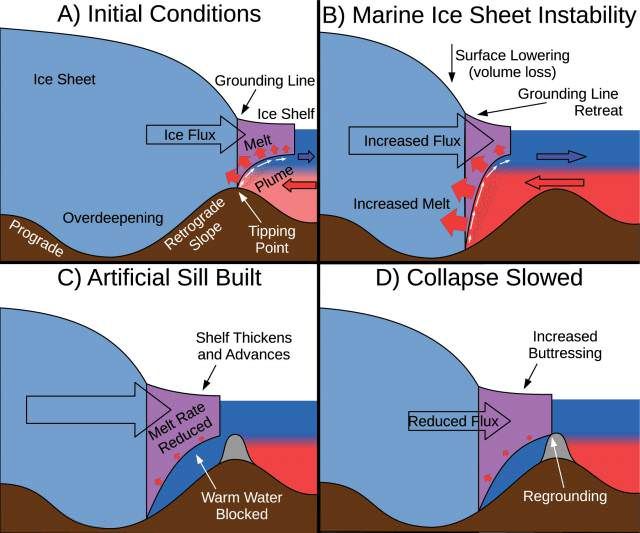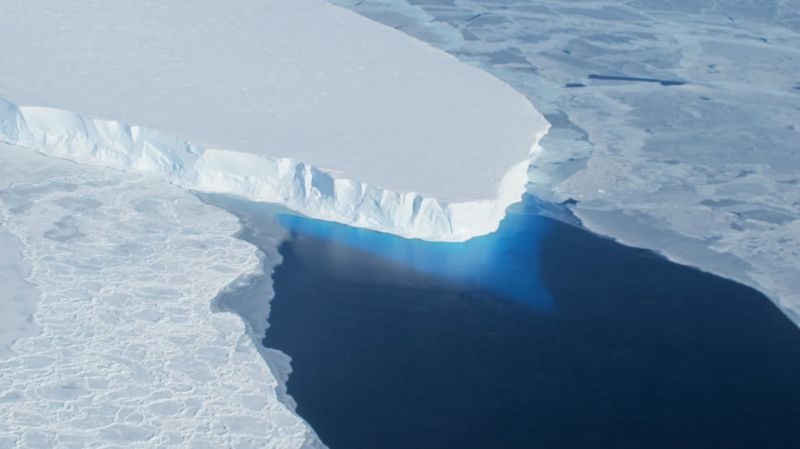Geoengineering Polar Glaciers to Slow Sea-level Rise
Published on by Water Network Research, Official research team of The Water Network in Academic
Targeted geoengineering to preserve continental ice sheets deserves serious research and investment, argues an international team of researchers in a Comment published in the journal Nature.
Without intervention, by 2100 most large coastal cities will face sea levels that are more than three feet higher than they are currently.

Ice sheets that spread from continental shelves to the ocean are highly vulnerable to melting near the grounding line, which is the point at which they lift off of the bedrock and start floating on the ocean (purple). Wolovick proposes building an artificial sill — an underwater wall 3 miles long and 350 feet high — to block warm water (red) from reaching the glacier. Diagram courtesy of Michael Wolovick
Previous discussions of geoengineering have looked at global projects, like seeding the atmosphere with particles to reflect more sunlight. That’s what makes this focused approach more feasible, says Michael Wolovick, a postdoctoral research associate in Atmospheric and Oceanic Sciences and a co-author on the Comment. (Nature editors commission Comments, short articles by one or more experts that call for action and lay out detailed solutions for current problems.)
“Geoengineering interventions can be targeted at specific negative consequences of climate change, rather than at the entire planet,” Wolovick said.
The ice sheets of Greenland and Antarctica will contribute more to sea-level rise this century than any other source, so stalling the fastest flows of ice into the oceans would buy us a few centuries to deal with climate change and protect coasts, say the authors.
“There is going to be some sea-level rise in the 21st century, but most models say that the ice sheets won’t begin collapsing in earnest until the 22nd or 23rd centuries,” said Wolovick. “I believe that what happens in the 22nd or 23rd centuries matters. I want our species and our civilization to last as long as possible, and that means that we need to make plans for the long term.”
Wolovick started investigating geoengineering approaches when he realized how disproportionate the scale was between the origin of the problem at the poles and its global impact: “For example, many of the most important outlet glaciers in Greenland are about 5 kilometers (3 miles) wide, and there are bridges that are longer than [that]. The important ice streams in Antarctica are wider, tens of kilometers up to 100 kilometers, but their societal consequences are larger as well, because they could potentially trigger a runaway marine ice sheet collapse. The fast-flowing parts of the ice sheets — the outlet glaciers and ice streams — might be the highest-leverage points in the whole climate system.”
The glaciers could be slowed in three ways: warm ocean waters could be prevented from reaching their bases and accelerating melting; the ice shelves where they start to float could be buttressed by building artificial islands in the sea; and the glacier beds could be dried by draining or freezing the thin film of water they slide on.
Read full article: Princeton

Thwaites Glacier, west Antarctica, Source: NASA, Image labeled for reuse
Media
Taxonomy
- GIS & Remote Sensing Technology
- Environment
- Climate Change
- Hydrogeology
- Oceanographic Survey
- Geo-hydrology
- Sea Level Rise Risk Perception
- Sea Level Rise Vulnerability Assesment
- Environmental Research
- Climate
- Ocean engineering
1 Comment
-
Science has not yet unraveled all the properties of water. We use it as a simple working fluid agent. Water affects not only the environment, but also the climate. As a result of human activity, the functions of the main part of the water have changed. Instead of keeping the biota by supplying it with moisture, mineral and organic substances, the water comes with precipitation and returns to the atmosphere by artificial evaporation from arable land, asphalt, reservoirs, dumps. In total, people took from nature 63% of the inhabited earth, each hectare of which contains 20 tons of underground living creatures. These are microbes, worms, etc. insects that, in symbiotic relationship with plants and terrestrial populations, absorb moisture, transform in food chains and economically exhale highly individual pairs, which we call natural or organic vapors. Human intervention in the circulation of water reduces food chains, and water from asphalt and other destroyed areas evaporates immediately after precipitation. We call these evaporation artificial. More artificial fumes are produced by industry and utilities around the world. Giant artificial evaporation creates unprecedented volumes of water in the atmosphere, which have changed for centuries the worked out mechanism of atmospheric phenomena. The cyclicity, massiveness and ranges of precipitation have changed. Therefore, some areas suffer from floods, and others - from drought and fires. Let us give an example of just one aspect - man-made reservoirs. Several hundred new reservoirs are being commissioned annually on the globe. The total area of all the reservoirs of the world is more than 600 thousand km2. Many of the world's rivers - the Volga, the Dnieper, the Angara, Missouri, Colorado, Parana and others - have been turned into cascades of reservoirs. Evaporation from their waters is artificial, nature is not provided.
The purpose of this speech is to attract the attention of the academic world to create a group for the proof of the Hypothesis. This will create a new unified concept for the preservation of life on the planet. The basis of this concept should be the all-round return to nature of organic fumes and the reduction of artificial fumes. Among measures to reduce artificial fumes should be the total total water saving in everyday life by each person. Complete and unconditional stop of projects and construction of reservoirs. Reconstruction of the entire agricultural sector with the introduction of unmanned plowing, drip irrigation, etc.
Наука еще не разгадала всех свойств воды. Мы используем ее, как простой рабочий текучий агент. Вода влияет не только на окружающую среду, но и на климат. В результате человеческой деятельности функции основной части воды изменились. Вместо того, чтобы содержать биоту путем поставки ей влаги, минеральных и органических веществ, вода приходит с осадками и возвращается в атмосферу искусственными испарениями от пахотных земель, асфальта, водохранилищ, свалок. В общей сложности человек отобрал у природы 63% обитаемой земли, каждый гектар которой содержит 20 тонн подземной живности. Это микробы, черви, и пр. насекомые, которые в симбиозе с растениями и наземным населением впитывают влагу, преобразовывают в пищевых цепочках и экономно выдыхают сугубо индивидуальные пары, которые мы называем естественными или органическими испарениями. Вмешательство человека в кругооборот воды сокращает пищевые цепочки, и вода с асфальта и прочих разрушенных территорий испаряется сразу после выпадения осадков. Назовем эти испарения искусственными. Еще больше искусственных паров производит индустрия и коммунальное хозяйство по всему миру. Гигантское искусственное испарение создает беспрецедентные объемы воды в атмосфере, которые изменили, веками отработанный механизм атмосферных явлений. Изменились цикличность, массивность и ареалы выпадения осадков. Поэтому некоторые районы страдают от наводнений, а другие - от засухи и пожаров. Приведем пример всего лишь одного аспекта – рукотворных водохранилищ. В настоящее время на земном шаре ежегодно в строй вводится несколько сот новых водохранилищ. Общая площадь всех водохранилищ мира более 600 тыс. км2. Многие реки земного шара – Волга, Днепр, Ангара, Миссури, Колорадо, Парана и другие – превращены в каскады водохранилищ. Испарения с их акваторий искусственны, природой не предусмотрены.
Целью настоящего выступления является привлечение внимания ученого мира для создания группы по доказательству изложенной Гипотезы. Это позволит создать новую единую концепцию по сохранению жизни на планете. Основой этой концепции должно стать всемерное возвращение природе органических испарений и сокращение искусственных. В числе мер по сокращению искусственных испарений должно стать всеобщая тотальная экономия воды в быту каждым человеком. Полная и безусловная остановка проектов и строительства водохранилищ. Реконструкция всего сельского хозяйства с введением безотвальной вспашки, капельного орошения и др.